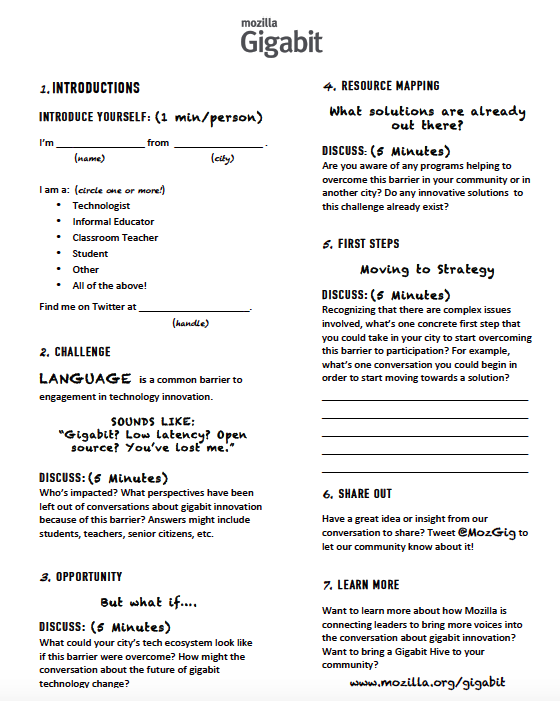Once the fiber is in the dirt, what do you do with it? What opportunities do blazing fast internet speeds create, and how do you leverage these opportunities to the benefit of everyone in your smart, connected community?
These were the central questions of June’s Smart Community Innovation Summit, a co-located convening of several national smart cities initiatives including the Global Cities Team Challenge and the US Ignite Application Summit.
Mozilla at the Smart Community Innovation Summit
For the third year, Mozilla partnered with US Ignite to share our Gigabit Community Fund projects at the Summit. Kansas City teams Pennez, The Gigabots, and PlanIt Impact joined Chattanooga team ViatoR to showcase their Mozilla-supported educational technology projects in front of the 1500+ conference attendees. Response to these gigabit-fueled educational projects was enthusiastic, and ViatoR – a virtual reality language learning tool – even won awards for Best Use of Low Latency and Best in Show at the US Ignite application showcase!
Mozilla’s Gigabit Hive work is an effort to connect technologists, informal educators, and classroom teachers to help shape the future of the Web. We’re connecting leaders across these sectors to bring in more voices as beta-testers and co-creators of gigabit tech. In so doing, we’re helping to build a more inclusive gigabit innovation ecosystem and making sure that the reality of these high-speed networks lives up to their promise. So while the application showcase highlighted the possibilities of gigabit speeds (“what do you do with it?”), Mozilla focused our 2016 Summit programming on expanding these opportunities to new corners of gigabit cities (“how do you you leverage these opportunities to the benefit of everyone in your community?”). Through panels and a design activity, we encouraged Summit participants to explore how gigabit networks could be used as a tool to overcome – rather than to reinforce – existing barriers and digital divides in their communities.
Exploring Solutions to Participation Barriers
Of course, barriers to digital inclusion are difficult to overcome, no matter the speed of a city’s network. However, building web technologies that are relevant and responsive to users’ demands that we confront these barriers to participation – regardless of their complexity – in order to bring more diverse voices into the conversation about the future of internet. Thus, we challenged US Ignite Application Summit participants to begin examining five common barriers to participation in the gigabit innovation ecosystem:
- Language: “Gigabit? Low latency? Open source? You’ve lost me”
- Access: “We don’t have devices in my classroom.”
- School Policy: “Gigabit? We can’t even use Skype in my classroom!”
- Connectivity: “It takes an hour to load a YouTube video in my classroom.”
- Awareness: “I don’t understand why fast networks matter.”
Using the design exercise worksheet below, participants worked in groups to share the challenges related to one of the above barriers, to explore the opportunities that would emerge from overcoming it, and to imagine some first steps towards solutions. From advocating for school policy changes with regard to firewalls to making sure that city websites were free of high-tech jargon, participants explored a range of possible solutions to the stated barriers. More important than the potential solution ideas generated though was the recognition and mapping of these common barriers across gigabit cities.
 Mozilla’s Gigabit Hive initiative uses gigabit implementation and innovation as a catalyst to start important conversations about digital inclusion and web literacy. Because high-speed networks are meaningless if everyday citizens lack the ability to participate in and benefit from these speeds, these conversations are critical to the smart and connected communities of the future. By connecting innovators and leaders from across sectors beyond standard technologist communities, Gigabit Hive amplifies these conversations in Kansas City, Chattanooga, Austin, and two new cities to be announced in 2017. If you would like to explore how you can leverage gigabit speeds to overcome divides and barriers in your own community, you can apply to become the next Gigabit Hive city by November 9.
Mozilla’s Gigabit Hive initiative uses gigabit implementation and innovation as a catalyst to start important conversations about digital inclusion and web literacy. Because high-speed networks are meaningless if everyday citizens lack the ability to participate in and benefit from these speeds, these conversations are critical to the smart and connected communities of the future. By connecting innovators and leaders from across sectors beyond standard technologist communities, Gigabit Hive amplifies these conversations in Kansas City, Chattanooga, Austin, and two new cities to be announced in 2017. If you would like to explore how you can leverage gigabit speeds to overcome divides and barriers in your own community, you can apply to become the next Gigabit Hive city by November 9.